Blueberry Pollination: The Role of Specialist Bees
go.ncsu.edu/readext?1068463
en Español / em Português
El inglés es el idioma de control de esta página. En la medida en que haya algún conflicto entre la traducción al inglés y la traducción, el inglés prevalece.
Al hacer clic en el enlace de traducción se activa un servicio de traducción gratuito para convertir la página al español. Al igual que con cualquier traducción por Internet, la conversión no es sensible al contexto y puede que no traduzca el texto en su significado original. NC State Extension no garantiza la exactitud del texto traducido. Por favor, tenga en cuenta que algunas aplicaciones y/o servicios pueden no funcionar como se espera cuando se traducen.
Português
Inglês é o idioma de controle desta página. Na medida que haja algum conflito entre o texto original em Inglês e a tradução, o Inglês prevalece.
Ao clicar no link de tradução, um serviço gratuito de tradução será ativado para converter a página para o Português. Como em qualquer tradução pela internet, a conversão não é sensivel ao contexto e pode não ocorrer a tradução para o significado orginal. O serviço de Extensão da Carolina do Norte (NC State Extension) não garante a exatidão do texto traduzido. Por favor, observe que algumas funções ou serviços podem não funcionar como esperado após a tradução.
English
English is the controlling language of this page. To the extent there is any conflict between the English text and the translation, English controls.
Clicking on the translation link activates a free translation service to convert the page to Spanish. As with any Internet translation, the conversion is not context-sensitive and may not translate the text to its original meaning. NC State Extension does not guarantee the accuracy of the translated text. Please note that some applications and/or services may not function as expected when translated.
Collapse ▲This is a guest post by Emma Payne. Emma is an NCSU zoology major and research assistant in the Youngsteadt Lab.
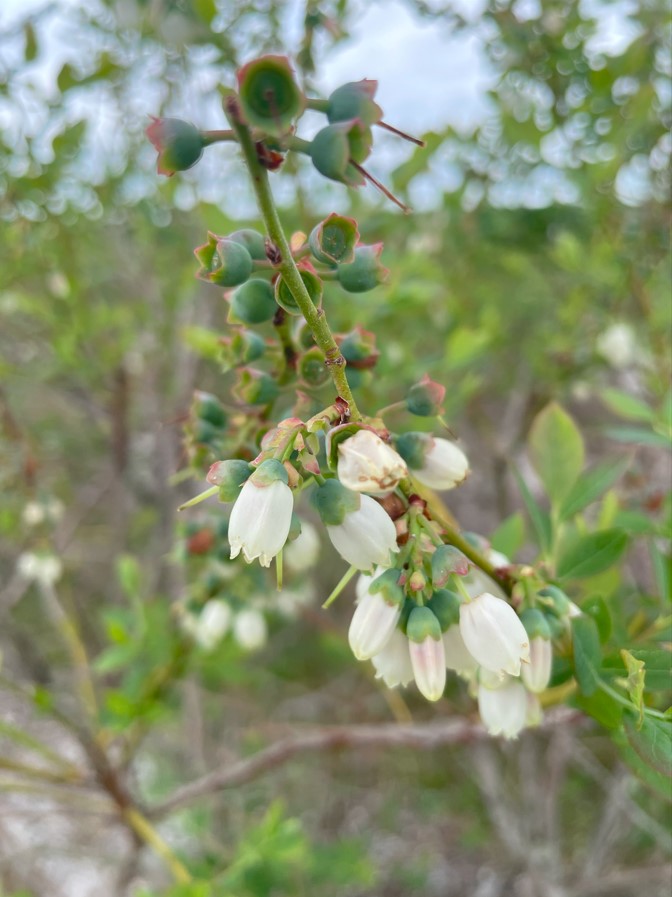
Each blueberry flower must be pollinated with 30-125 pollen grains to maximize fruit set, berry weight, and ripening speed. Photo by Emma Payne.
Gardens are filled with generalist bees, such as honey bees and bumble bees, that pollinate a wide variety of plants. However, if you want to maximize your blueberry yield while supporting biodiversity, specialist bees play a major role. Unlike generalists, specialist bees focus on pollinating a limited range of plants, making them highly efficient pollinators for those species. With blueberry bloom underway, let’s explore some of North Carolina’s blueberry specialist bees and how they can benefit your garden.
How Bees Help Blueberries
Buzz Pollination: An Effective Method
Some specialist bees, as well as bumble bees, employ a fascinating technique called buzz pollination to access pollen more effectively. Blueberry flowers have a cup-shaped structure that makes it difficult for their pollen to be released. Additionally, the pollen’s heavy and sticky nature limits the effectiveness of wind in pollination (3). Specialist bees, such as the Southeastern blueberry bee (Habropoda laboriosa), grip the flower and vibrate their thoracic muscles at a high frequency, causing the flower to release pollen (4).
While honey bees generally contribute to higher overall blueberry yields, they can’t buzz pollinate. Some specialist bees are more effective pollinators per flower visit than honey bees (12,13), resulting in several benefits for blueberry plants:
- Increased fruit set – More flowers successfully develop into blueberries.
- Larger, more uniform fruit – The enhanced pollination results in better-formed berries (6,10).
Encouraging a diverse pollinator population in your garden can enhance fruit production while promoting a resilient ecosystem.
Meet the Blueberry Specialist Bees
Specialist bees primarily collect pollen from a limited range of plants, adapting to specific flower structures for efficient pollen harvesting. Below are some key blueberry specialist bees found in North Carolina:
Southeastern Blueberry Bee (Habropoda laboriosa)
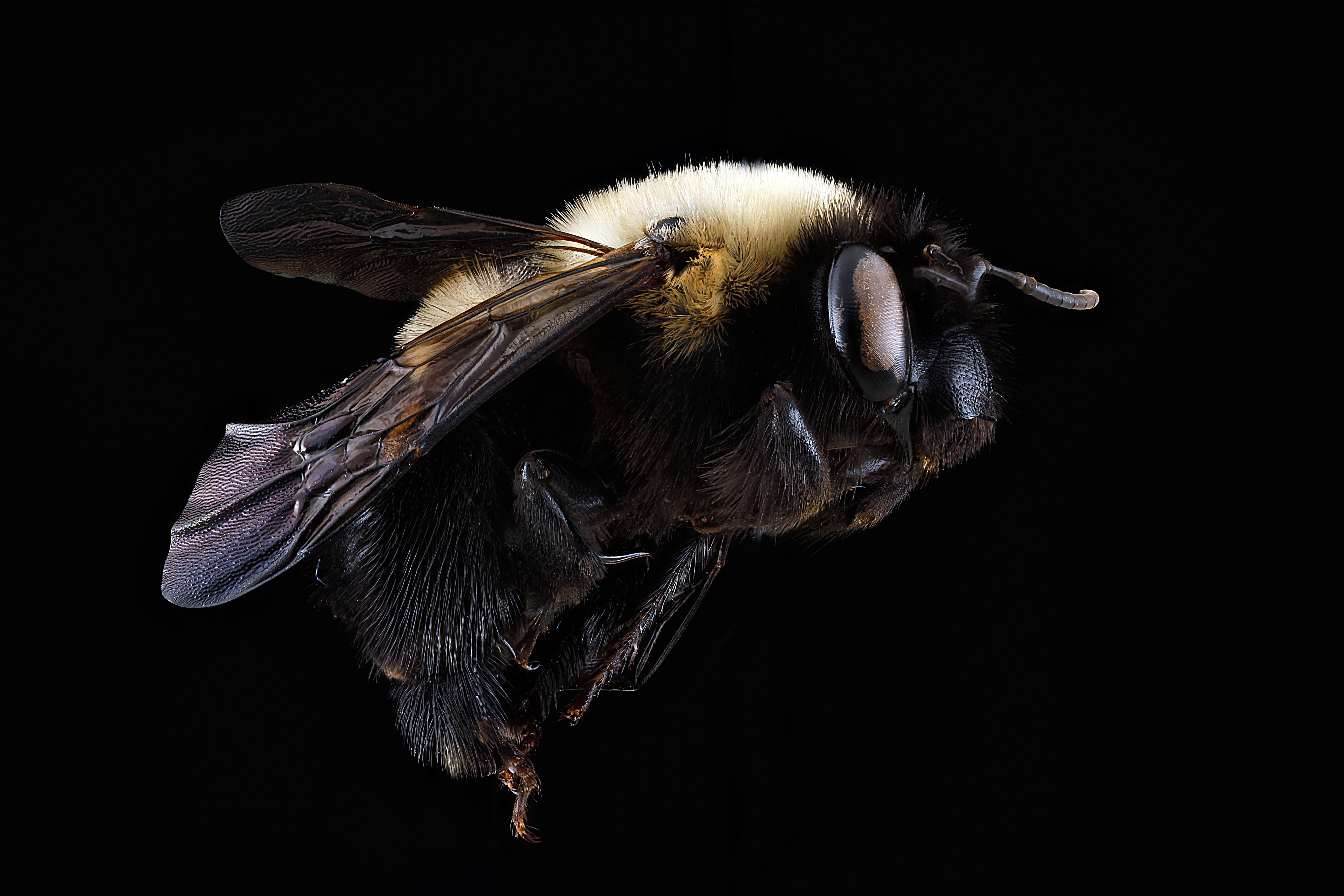
In her lifetime, a female Southeastern blueberry bee (Habropoda laboriosa) may visit 50,000 blueberry flowers, yielding more than 6,000 ripe blueberries. Photo by USGS Bee Inventory and Monitoring Laboratory
- Resembles a small, fuzzy bumble bee with a stocky body covered in dense hairs and a shiny black abdomen
- Active only during the blueberry flowering season
- Highly efficient buzz pollinator, using wing vibrations for pollen release
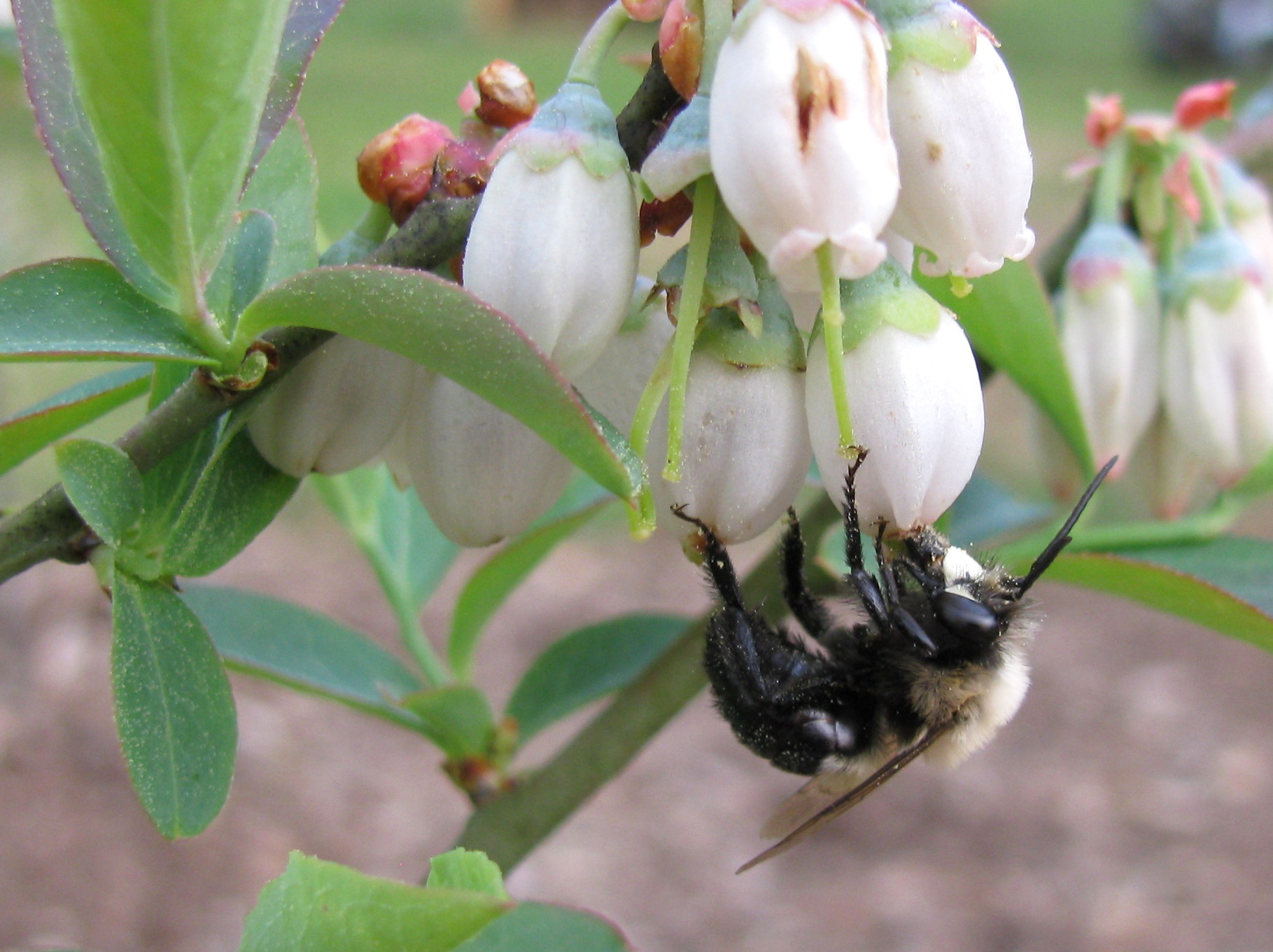
A male Southeastern blueberry bee (Habropoda laboriosa) visiting blueberry blooms. Males have a pale-colored face, while females’ faces are black. Photo by Elsa Youngsteadt.
Bradley’s Andrena (Andrena bradleyi)
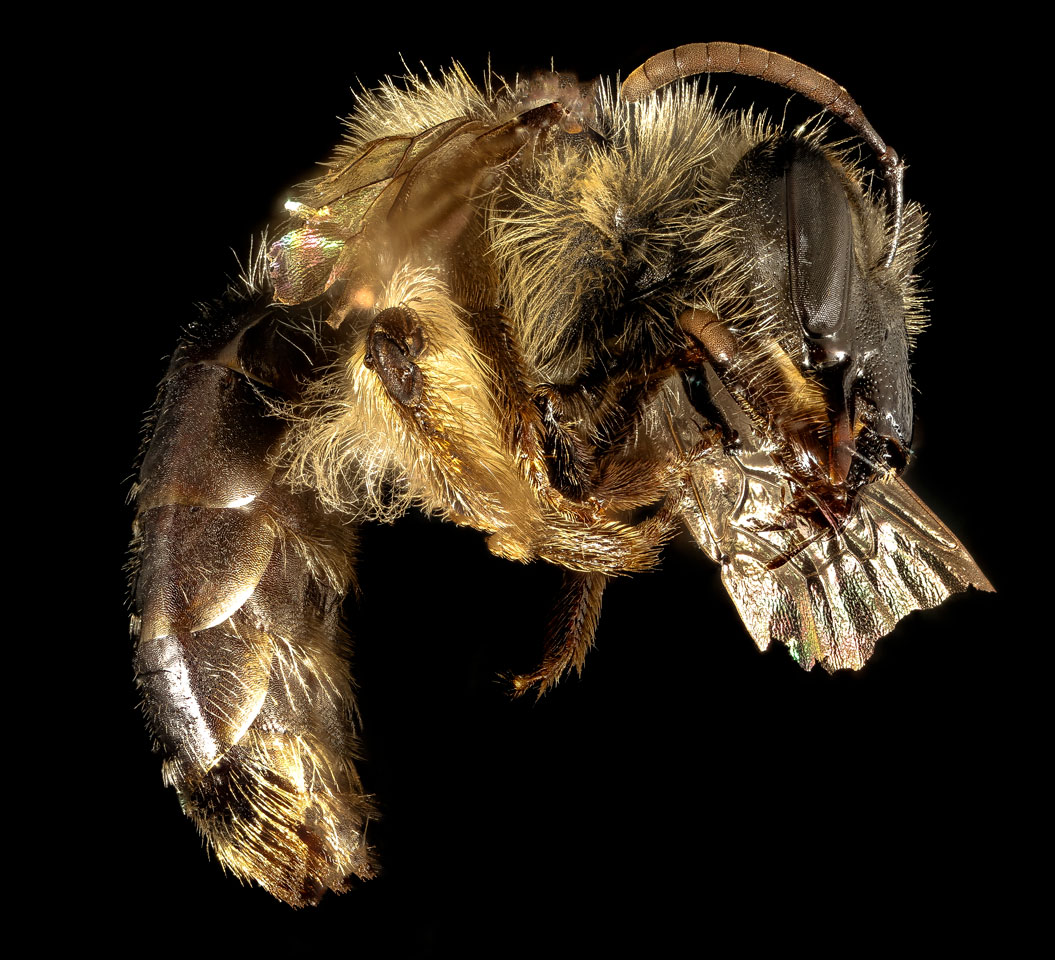
Bradley’s Andrena (Andrena bradleyi) appears to thrive on blueberry farms, and is one of the most common native bees found pollinating cultivated blueberries in North Carolina. Photo by the USGS Bee Inventory and Monitoring Laboratory.
- Smaller than a honey bee, with a long, narrow face adapted for reaching blueberry nectar deep inside the cup-shaped flower
- Relies on lowbush and highbush blueberry plants for sustenance
- Solitary, with each female independently nesting and foraging–but often forms large ‘neighborhoods’ of nearby nests in prime locations
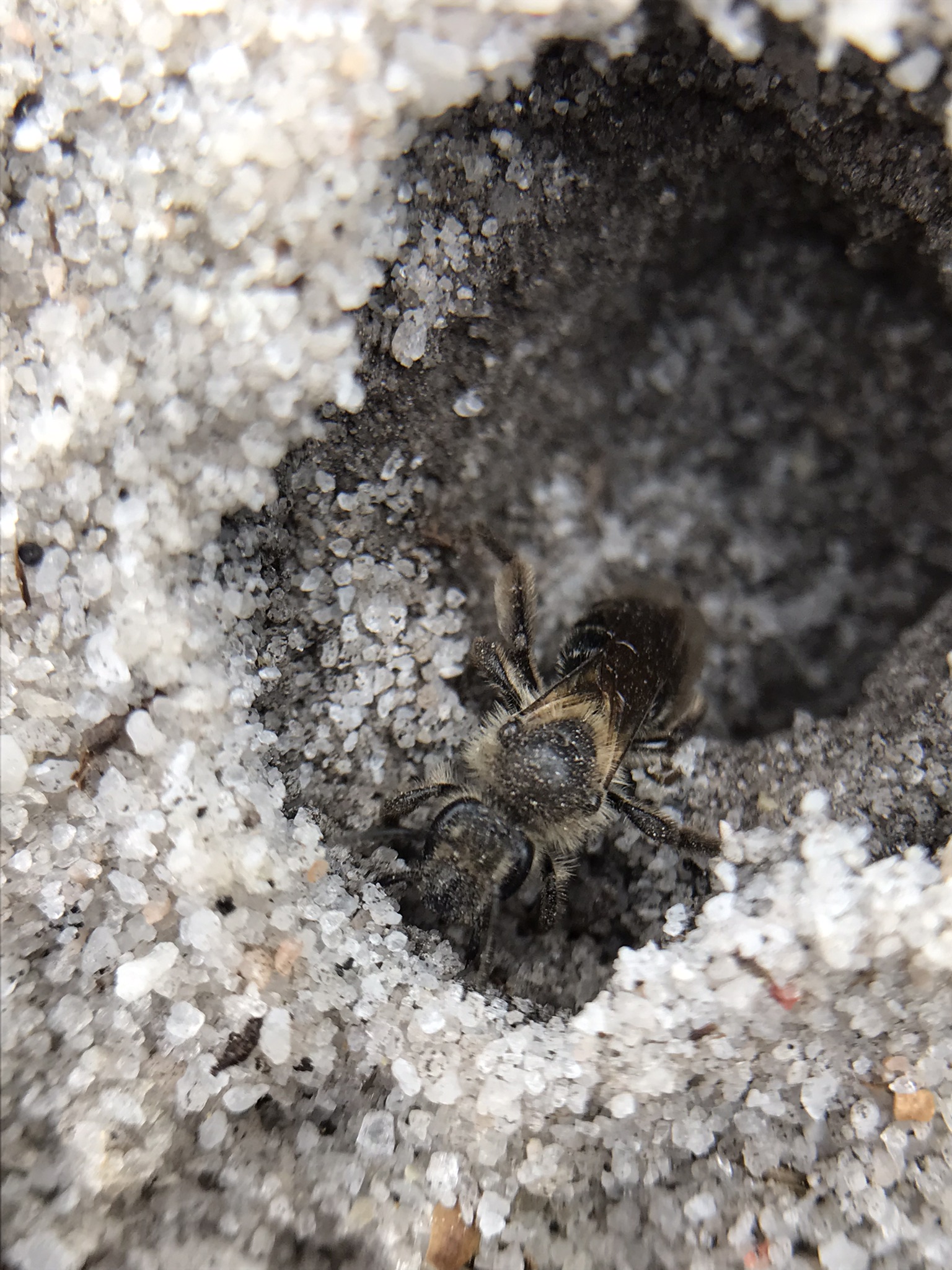
A female Andrena bradleyi at her nest entrance in sandy soil. Nests extend 6-12″ below the soil surface. Photo by Elsa Youngsteadt.
Blueberry Cellophane Bee (Colletes validus)

The blueberry cellophane bee (Colletes validus) has a strong preference for blueberry pollen, although they will also collect pollen from pines and other spring-flowering plants. Photo by the USGS Bee Inventory and Monitoring Laboratory.
- About the size of a honey bee, recognizable by its long, triangular face
- Active from late February through April, coinciding with blueberry blooms
- Named for the characteristic, cellophane-like covering that these bees secrete to line their nests
How to Attract and Support Blueberry Specialist Bees
If you want to encourage blueberry specialist bees in your garden, consider the implementing the following practices:
- Plant blueberry bushes – Choose native or well-adapted varieties to provide a reliable pollen source. You can find more details on blueberries for home gardens here.
- Preserve nesting habitats – These specialist bees are ground-nesters that prefer sandy soil near host plants (within about a city block). Most bees will not nest under mulch or dense turf, preferring bare soil, sparsely vegetated areas, or a thin layer of pine straw. To help, you can limit mulching and maintain undisturbed soil patches (4,7).
- Minimize pesticide use – Opt for pollinator-friendly pest management strategies to avoid harming beneficial bees. You can find more details on minimizing pesticide risk to pollinators in home landscapes here.
- Alternative Post-bloom floral resources – Additional native plants, such as willow, can help sustain bees once blueberry flowering ends (14). This is especially important for generalists like bumble bees who need a variety of flowers throughout the growing season. Even blueberry specialists may switch to other plants before and after blueberry bloom (16).
Conclusion
Specialist bees and blueberry plants form a mutually beneficial relationship that enhances fruit production and supports pollinator populations. By fostering a bee-friendly environment in your garden, you not only improve your blueberry harvest but also contribute to overall ecosystem biodiversity. Consider planting more blueberries and preserving bee habitats to welcome these interesting and essential pollinators into your garden.
Sources
- Batra, S. W. T. (1980). Ecology, behavior, pheromones, parasites and management of the sympatric vernal bees Colletes inaequalis, C. thoracicus, and C. validus. Journal of the Kansas Entomological Society, 53(3), 509–538.
- Brewer, J. W., & Dobson, R. C. (1969). Pollen analysis of two highbush blueberry varieties. Journal of the American Society for Horticultural Science, 94, 251-252.
- Burrack, H. (2014). Blueberry Pollinators. NCSU.edu. Retrieved from https://entomology.ces.ncsu.edu/small-fruit-insect-biology-management/blueberry-pollinators/
- Cane, J. H. (1994). Nesting biology and mating behavior of the southeastern blueberry bee, Habropoda laboriosa(Hymenoptera: Apoidea). Journal of the Kansas Entomological Society, 67(3), 236–241.
- Cane, J. H., & Payne, J. A. (1988). Foraging ecology of the bee Habropoda laboriosa, an oligolege of blueberries in the southeastern United States. Annals of the Entomological Society of America, 81(3), 419–427.
- Cane, J. H., Sampson, B. J., & Miller, S. A. (2011). Pollination value of specialist bees at blueberries. Environmental Entomology, 40(3), 614-620.
- Colletidae nesting biology (Hymenoptera: Apoidea). Almeida, E. A. B. (2008). Apidologie, 39(1), 16-29. DOI: 10.1051/apido:2007049
- Graham, K. K., Milbrath, M. O., Killewald, M., Soehnlen, A., Zhang, Y., & Isaacs, R. (2023). Identity and diversity of pollens collected by two managed bee species while in blueberry fields for pollination. Environmental Entomology, 52(5), 907–917. https://doi.org/10.1093/ee/nvad072
- Javorek, S. K., Mackenzie, K. E., & Vander Kloet, S. P. (2002). Comparative pollination effectiveness among bees (Hymenoptera: Apoidea) on lowbush blueberry (Ericaceae: Vaccinium angustifolium). Annals of the Entomological Society of America, 95(3), 345-351.
- Nicholson, C. C., & Ricketts, T. H. (2019). Wild pollinators improve production, uniformity, and timing of blueberry crops. Agriculture, Ecosystems & Environment, 272, 29-37.
- Stubbs, C. S., & Drummond, F. A. (2001). Pollination of wild lowbush blueberries by native bees in Maine. Northeastern Naturalist, 8(2), 241-252.
- Sun, Q., Zhao, X., Wu, L., Zhao, J., Yang, Y., & Zhang, Y. (2021). Differences in pollination efficiency among three bee species in a greenhouse and their effects on yield and fruit quality of Northern Highbush ‘Bluecrop’ blueberry. HortScience, 56(5), 603-607.
- Tuell, J. K., Fiedler, A. K., Landis, D., & Isaacs, R. (2009). Pollination efficiency of native bees on blueberry crops. Journal of Economic Entomology, 102(2), 563-573.
- Watson, J. B., Bartel, K. G., & Gibbs, J. (2023). Willow pollen collection by a blueberry specialist bee (Hymenoptera: Andrenidae). The Great Lakes Entomologist, 56(2). https://doi.org/10.22543/0090-0222.2466
- Kilpatrick, S. K., & López-Uribe, M. M. (2020). Andrenidae. Retrieved June 29, 2020, from http://lopezuribelab.com/andrenidae/
- Watson et al. (2023). Willow Pollen Collection by a Blueberry Specialist Bee (Hymenoptera: Andrenidae). The Great Lakes Entomologist, vol 56 (2). https://doi.org/10.22543/0090-0222.2466


